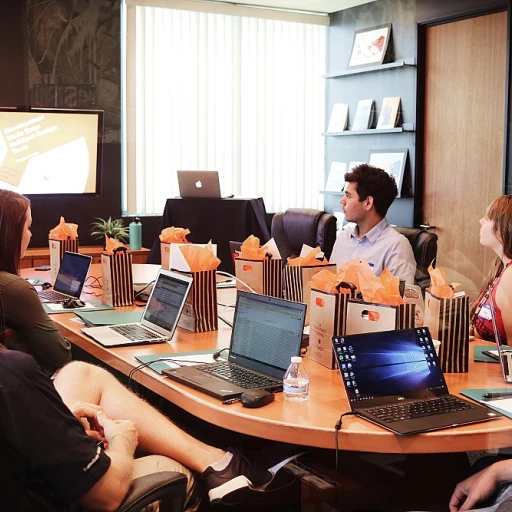Understanding the Need for Career Transition Partnerships
Recognizing the Importance of Collaboration in Career Transition
In the fast-paced and ever-changing job market, career transitions have become a common aspect of professional life. Whether you're leaving the armed forces or shifting roles in the civilian workforce, the process can be daunting. Service leavers, in particular, often require substantial transition support to navigate their way into new civilian career paths successfully.
Effective career transition partnerships are essential to providing the necessary support for individuals seeking new employment opportunities after years of service. These partnerships can offer a wide range of services such as resettlement support, vocational training, and employment fairs designed to ease the transition to civilian life.
Organizations like the Ministry of Defence and CTP (Career Transition Partnership) work in tandem to smoothen this process. Their focus includes providing leavers with the training courses and skills needed to re-enter the workforce.
It's crucial to understand the need for these partnerships, especially when considering the challenges faced by those transitioning from armed forces employment to civilian roles. By fostering connections between service personnel and the right resources, these partnerships help tackle potential obstacles, ensuring a more seamless shift into new careers.
This resource can provide deeper insights into the evolving nature of career transitions and the role of partnerships in supporting them.
Identifying the Right Partners for Your Career Transition
Choosing the Appropriate Allies for Your Journey
Embarking on a career transition can be challenging, especially for individuals leaving the armed forces. Identifying the right partners can significantly streamline this process, ensuring effective resettlement into civilian life. Let's explore how to determine the optimal partners for your career journey. First, it's essential to recognize the support you require. Whether it's vocational training, employment support, or access to a wide range of services, pinpointing your needs is crucial. If you're a service leaver, partnerships like the Reed Partnership, which collaborate with the Ministry of Defence, can offer tailored resettlement support through various training courses and employment fairs. Finding partnership CTP (Career Transition Partners) that understand the unique pressures faced by armed forces leavers can be transformative. For instance, organizations that provide digital platforms for personalized training programs can help enhance employability by building relevant skills for civilian employment. Furthermore, seeking partners who mirror your personal and professional aspirations can facilitate a smoother transition. Look for services with a track record of assisting service leavers in gaining skills and settling into civilian careers effectively. This may include support services that sustain career transitions and extend beyond initial employment placement, offering long-term vocational growth opportunities. Ultimately, the right partnership should not only contribute to immediate job resettlement but also to your long-term career growth. As you explore potential partnerships, consider a blend of organizations that harmonize education retirement and career transition goals, thereby fostering a more holistic approach to your career path. To learn more about fostering effective partnerships, you might find insightful resources on enhancing employee engagement through strategic HR management.Building Effective Communication Channels
Establishing Clear and Open Communication Lines
Building effective communication channels is vital in fostering a robust career transition partnership. Clear communication ensures all parties understand their roles, expectations, and objectives. It also allows partners to navigate resettlement challenges effectively, especially for service leavers moving into civilian life. Creating a seamless flow of information is essential during a career transition. Organizations can utilize both traditional and digital platforms to establish dependable communication networks. These channels not only enhance service delivery but also facilitate timely access to crucial employment support. Cultural and Vocational Understanding Understanding the unique needs of individuals transitioning from the armed forces to civilian employment is crucial. Armed forces personnel often require support in adapting their military-acquired skills to civilian job markets. Career transition partnerships can offer help service through education retirement programs and vocational training to address this. Communicating the value of training courses tailored to service leavers is a meaningful way to bridge this gap. During these conversations, highlight the wide range of skills applicable in the civilian sector, ensuring they are well-prepared to navigate their new career paths. Leveraging Technology for Open Dialogue New technologies offer platforms that fill communication gaps within career transition partnerships. With digital platforms, organizations can conduct virtual employment fairs, webinars, and training sessions, bridging geographical constraints and allowing access to an array of resources. This technological integration ensures a broad reach of education and training offerings. Furthermore, maintaining an online repository of support services and courses can significantly enhance understanding and timely resettlement action. For more insights into how strategic communication impacts career transition, explore Building Communication Strategies that empower transitions. To foster a successful career transition partnership, prioritizing open communication and utilizing cutting-edge technology is paramount. These efforts not only personalize the services rendered but also facilitate a smoother transition for those moving into civilian employment.Leveraging Technology in Career Transition Partnerships
Embracing Modern Tools for Seamless Career Shifts
In today's digital world, leveraging technology is paramount for successful career transition partnerships. The use of technology in these partnerships provides a foundation for improved communication, comprehensive resettlement support, and access to a wide range of resources for service leavers and career changers alike. To support service leavers, particularly those from the armed forces, accessing a digital platform tailored to career transition can bridge the gap between leaving a structured environment and entering civilian life.
These platforms offer a range of services, from personalized vocational training to extensive databases of employment opportunities. By utilizing technology, career seekers can easily connect with the right partners for their transition, accessing vital support service resources such as employment fairs and resettlement support. These tools are crafted to provide seamless access to training courses and employment support, enhancing their skills portfolio and aligning with civilian employment demands.
The Ministry of Defence and employment support organizations such as the CTP Reed Partnership have recognized the importance of integrating digital solutions within career transition pathways. This approach not only facilitates the management of personal educational and employment journeys but also enriches the partnership by providing real-time updates, feedback mechanisms, and tailored training opportunities.
Furthermore, technology helps break down communication barriers and ensures all parties involved in the transition partnership are aligned. From the armed forces to civilian employers, digital platforms ensure a continuous flow of information, making it easier for individuals to transition smoothly and confidently into their new roles.
Overcoming Challenges in Career Transition Partnerships
Addressing Common Obstacles in Career Transition Partnerships
Transitioning from the armed forces to civilian life is a significant step, and career transition partnerships (CTPs) play a crucial role in facilitating this journey. However, these partnerships often face challenges that can hinder their effectiveness. Understanding and addressing these obstacles is vital for the success of any transition initiative.
Communication Barriers
Effective communication is the backbone of any successful partnership. In the context of career transitions, clear communication channels between service leavers and support services are essential. Misunderstandings can arise due to differences in military and civilian terminologies, leading to confusion about the available resources and support. Regular feedback loops and open dialogue can help bridge these gaps, ensuring that both parties are aligned in their goals.
Technology Integration
Leveraging technology can streamline processes and improve access to a wide range of resources. However, the digital divide can pose a challenge, particularly for those who may not be familiar with modern digital platforms. Providing training courses on how to use these technologies can enhance the overall experience for service leavers, ensuring they have the necessary skills to navigate their career transition effectively.
Resource Allocation
Another common challenge is the allocation of resources. Ensuring that there is adequate resettlement support, vocational training, and employment support can be difficult, especially with limited budgets. Partnerships must prioritize these resources effectively to maximize their impact. Collaborating with organizations like the Ministry of Defence and the Reed Partnership can provide additional support and funding opportunities.
Personal and Emotional Challenges
Transitioning from military to civilian life can be emotionally taxing. The change in environment and lifestyle requires significant personal adjustment. CTPs should offer comprehensive support services that address not only the professional but also the personal aspects of transition. This includes access to counseling and mentorship programs that can help service leavers adjust to their new roles and environments.
By proactively addressing these challenges, career transition partnerships can provide more effective and supportive pathways for those leaving the armed forces, ensuring a smoother transition into civilian employment and life.
Measuring the Success of Your Career Transition Partnership
Evaluating the Outcomes of Your Career Transition Collaboration
In the dynamic and often challenging landscape of career transitions, measuring the success of your career transition partnership (CTP) is crucial. This evaluation not only helps in understanding the effectiveness of your strategies but also in identifying areas for improvement to support service leavers and promote sustainable employment outcomes.
- Performance Metrics: Start by tracking key performance indicators such as employment rates, retention rates, and the quality of resettlement support provided. These metrics will give you a quantifiable measure of success and help in setting realistic benchmarks for improvement.
- Feedback and Surveys: Regular feedback from both job seekers and employers participating in the career transition process can provide invaluable insights. Using surveys to gather this information helps refine services and align better with the needs of those transitioning to civilian life.
- Partnership Evaluation: Assess the effectiveness of the partnership itself. Are your chosen partners delivering on their promises? Is the communication channel productive? An honest evaluation will determine if the partnership needs restructuring or even terminating.
- Skill Development Outcomes: Evaluate how training courses and vocational training have contributed to the employment success of service leavers. This includes investigating whether the skills acquired meet the demands of the civilian job market.
- Technology Utilization: Review how effectively technology has been leveraged within the transition partnerships. A modern digital platform can ease access to support services, providing a smooth journey for those entering the civilian workforce.
Ultimately, measuring the success of your transition partnership involves a comprehensive analysis of both quantitative data and qualitative feedback. By focusing on these evaluation strategies, organizations can refine their approach to career transition and foster meaningful resettlement pathways for armed forces personnel. A thriving transition partnership can significantly impact the confidence and competency of leavers, ensuring they are well-equipped for their new roles in civilian life.












